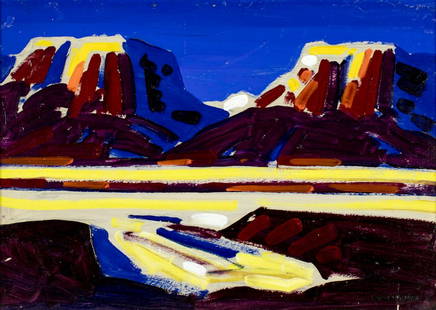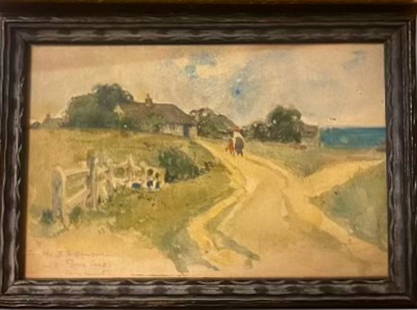
FRANCESCO SPICUZZA (1883-1962, Wisconsin) Landscape
Similar Sale History
View More Items in PaintingsRelated Paintings
More Items in Impressionist Paintings
View MoreRecommended Art
View More





Item Details
Description
Oil on board 16 x 12 in., 21 1/4 x 17 1/4 in. (framed). From askart.com: Italian-born Francesco Spicuzza was primarily a Wisconsin painter who did portraits, still-lives and local landscapes. He spent the first part of his life in near-poverty to become a painter. An eternal optimist, in 1917, the artist reported: "I am happy and my only ambition now is to paint better and better until I shall have reached the measure of the best of which I am capable." (Spicuzza, 1917, p. 22). His predilection for beach scenes germinated early: reportedly, the five-year-old boy first drew the outlines of his father's fishing boat in the sand on the seashore near their home in Sicily. After setting himself up as a fruit peddler in Milwaukee, Spicuzza's father sent for his family when Francesco was eight years old. For the following six years the boy was unable to attend school because of his job in his father's fruit and vegetable business. The poor lad suffered a caved-in shoulder from carrying a heavy wooden crate. The young Spicuzza was aided by moral and financial support from a sympathetic Milwaukee businessman named John Cramer, publisher and editor of the Evening Wisconsin, who raised Spicuzza's salary as a newspaper assembler so that he could attend school. In 1899 or 1900, Spicuzza began studying drawing and anatomy under Robert Schade (1861-1912), a painter of panoramas who had been trained in Munich under Carl Theodor von Piloty. Spicuzza was also taught by Alexander Mueller (1872-1935), a product of the Weimar and Munich academies. Mueller realized Spicuzza was a colorist and encouraged that orientation (Madle, 1961). Spicuzza found it beneficial to accept an apprenticeship in a lithographic studio for $8 a week, which demanded most of his time. During the St. Louis Universal Exposition in 1904, still a struggling student, Spicuzza attended the fair, thanks to Cramer. It was not long before Spicuzza received a twenty-five dollar portrait commission, and this inaugural success led to new commissions and allowed him to continue as a painter.The earliest influences in his work appear to be from Edward H. Potthast and Maurice Prendergast, though Spicuzza never mentioned either artist. Already in August 1910, Spicuzza was described in a newspaper as "one of the most talented of Milwaukee's rising workers." He undoubtedly received lasting inspiration from his one summer study period in 1911 with John F. Carlson at the Art Students League's Summer School in Woodstock, New York. Certainly Spicuzza would have picked up spontaneity in handling the brush from Carlson. Although he executed numerous still-lives and an occasional religious work, Spicuzza is best known for his Milwaukee beach scenes populated with frolicking bathers in multi-colored attire, not unlike the images of Potthast, who used a similar technique. Many of these are small, preparatory works on canvas board executed between 1910 and 1915. Frequently with even greater animation than Potthast, Spicuzza produced moving images of youthful energy and uninhibited child's play. These beach genre scenes reflect the attitude of American impressionists who depicted the more pleasant side of life.Spicuzza manipulated a successful balance of rich pigment applied in varying degrees of impasto texture with subtle nuances of hue. Working all'aperto, he sought "the soft enticing shades of yellow, blue, green, pink and lavender . . . to get the effects of bright glistening summer air." (L.E.S., n.d.). As a painter whose color not only derived from direct observation but also from a personal theory of color symbolism, Spicuzza traded the linear approach of lithography for dynamic patches of brilliant color. Like Prendergast, he would often tilt the angle of the picture plane to bring the viewer's position above the scene. Spicuzza was unable to enter the 1913 Armory Show or the Panama-Pacific International Exposition two years later but he did submit work to the annual exhibitions of the Pennsylvania Academy of the Fine Arts and those of the Art Institute of Chicago. His first important award was the bronze medal presented by the St. Paul Institute in 1913, which was followed by the silver medal two years later. Before long, Spicuzza had acquired a greater sense of security in his profession and was described by a writer in International Studio (April 1917) as "an independent artist with an assured future. His pastels and water-colours are poetic and joyous bits of nature with a genuine out-of-door feeling." In 1918, his Spirit of Youth, exhibited at the National Academy of Design, sold for $112.50. Four years later, the artist achieved his greatest local recognition by winning the gold medal from the Milwaukee Art Institute. Spicuzza spent a great deal of time painting en plein air and by 1925 he began summering at Big Cedar Lake, near West Bend, Wisconsin to gather his subject matter. Easter Morning (1926) owes something to the Symbolist movement, with its figure of Christ appearing over a seascape. During the difficult era of the Depression, patrons came to Spicuzza's aid and during the 40s, he taught housewives, businessmen and students at the Milwaukee Art Institute, the Milwaukee Art Center, and in his private studio. In the following decade, although his kind of art was no longer popular in the "make-it-or-break-it" New York gallery world, Spicuzza enjoyed regular patronage and sales. His beach scenes became more static and he would experiment with modernist techniques. Spicuzza died at the age of seventy-eight.Sources: L.E.S., "Do Colors Change a Person's disposition? Experiments of a Milwaukee Artist Prove It." Unidentified newspaper clipping, n.d.; Spicuzza, Francesco. "Artist's Life, A Romance of Bitter Toil." The Milwaukee Shopper's Guide, March 1917, p. 22; May 1917, pp. 25-28; June 1917, p. 24; "In the Journal's Loan Exhibit of Wisconsin Art." Milwaukee Journal, 24 November 1924, p. 4; "Expositions d'Amérique," Revue du Vrai et du Beau 6 (1927): 14; "People are Like That. Francesco J. Spicuzza, Artist." Unidentified newspaper clipping, 1928; Butts, Porter and Oskar Hagen. Art in Wisconsin: The Art Experience in the Middle West Frontier. Madison, WI: Madison Art Association, 1936, p. 198; Madle, Dorothy. "Spicuzza - Exponent of Joy and Life." Milwaukee Sentinel, 12 November 1961; Key, Donald. Spicuzza Paintings Make Sunny Memorial Show." Milwaukee Journal, 15 July 1962; Davidson, Sandra C. and Susan Werner O'Day. Francesco Spicuzza: An American Impressionist. Exh. cat. Norton, MA: Watson Gallery, Wheaton College, 1982; Basquin, Kit. Francesco Spicuzza: Wisconsin Impressionist. Exh. cat. Milwaukee, WI: The Haggerty Museum of Art, 1992.Submitted by Richard H. Love and Michael Preston Worley, Ph.D.
Condition
Good condition
Buyer's Premium
- 25%
FRANCESCO SPICUZZA (1883-1962, Wisconsin) Landscape
Estimate $800 - $1,200
10 bidders are watching this item.
Shipping & Pickup Options
Item located in Margate City, NJ, usSee Policy for Shipping
Payment

TOP














































































